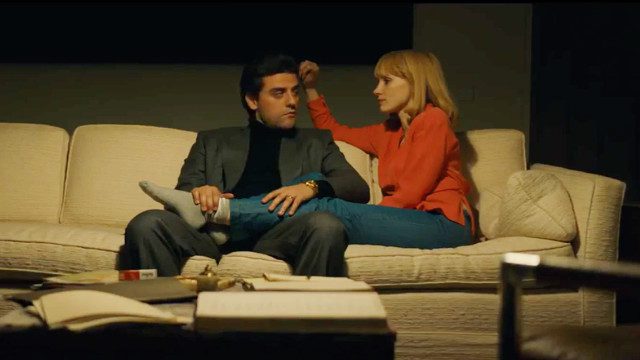Abel Morales is a man who wants nothing more than to succeed at running a legitimate business. The son of immigrants, he has worked hard all his life to not succumb to the crime that surrounds him. Played by the remarkably talented Oscar Isaac, when A Most Violent Year starts he’s running through his neighborhood, a man literally chasing the American dream. He’s just moved the family into a posh house and is on the verge of finishing a deal to own some riverside property perfect for importing and storing the heating oil his business sells. In thirty days he must close or face losing out to one of his many competitors. Complicating matters, his trucks are regularly being hijacked and his drivers assaulted. He has no idea who is doing it or how to stop them. Oh, and the district attorney who’s been investigating his company for two years in an effort to stamp out industry-wide corruption is about to introduce charges that could destroy everything he’s built.
Isaac, the incredibly versatile and dynamic lead who was crucial in making Inside Llewyn Davis one of the best Coen brother films last year, looms over the film like a modern-day Al Pacino. He’s coiled and magnetic; all internal wrestling and rage with a level-headed exterior. In one of the few scenes that plays like it has a pulse, he explains with no-nonsense directness the importance of making the sale to some new hires. “Always take the fancier option,” he coaches them about offers when going door to door (tea over coffee, homemade lemonade over soda, etc) before explaining how long to sustain eye contact. Isaac is, like the movie, all dressed up with essentially nowhere to go though. The same could be said for Albert Brooks, cast for some reason in the part as their street-wise lawyer (this isn’t a part that pays off like his surprising mobster turn in Drive) and the immensely talented David Oyelowo as the district attorney.
Jessica Chastain gives a razor-sharp performance as Anna, his glamorous wife who also runs the company’s books. She’s shrewd and tough; at once support and the devil of temptation on his shoulder. Alas she disappears for entire stretches and too much of the drama between them feels tacked on and a little hackneyed anyway, like when she reacts to her husband’s indecisiveness in protecting the family after their home is terrorized by arming herself (he berates her for buying a gun “that whores use”).
A Most Violent Year is set in New York City in 1981. The title is stately but misleading: it takes place over the span of one month, not an entire year. And there’s ultimately not much violence either, just a lot of ominousness and foreboding. It does precious little to allude to or acknowledge its era either (the opposite problem of being too referential about it). The picture really could have been set more or less any point in the last several decades. You can nevertheless see why J.C. Chandor wanted to set it when he did. The homicide rate in New York the year before the film is set was a whopping three times higher than it is today; the rate of property crime likely much higher too. It was a scarier time and good people-or people who want to do good-had cause to worry.
For Morales it’s the dilemma of whether the rampant theft and indictment will hold him back from closing the deal on time. Everything he’s worked for is at stake, we’re oft reminded. The drama that underlies it is the thorny question of how much he will have to compromise his own stated values to get there. As the signs of legal troubles mount, the financial backing starts to back off. Things get irrevocably messy when the drivers start carrying weapons and one of them (another immigrant, played by Elyes Gabel) gets into a shoot-out with the goons on the freeway and becomes a fugitive after fleeing the scene. Problem is that the material is too thin and the approach is too leaden, even with the brief jolt of bullets flying or a good chase. Trying to talk investors into giving you money or worrying about the penalty for unlicensed gun possession just doesn’t make for especially exciting cinema.
Thoughts of epics like The Godfather are never far from mind. Even the faint, eerie synthesized score from Edward Sharpe & The Magnetic Zeros frontman Alex Ebert feels like regurgitations–or at least, pale reflections of the music in crime movies from decades ago. A Most Violent Year strives nakedly for timelessness and a respectable artistic pedigree. But there’s no heat in Chandor’s filmmaking, just a cold peering gaze and exquisite nearly-to-a-fault design (the cinematography by Bradford Young, who also shot the stunning Selma, is unimpeachably gorgeous). A hot pursuit through the iconic city of one of the thieves that should finally yield some blood and sweat and answers is all build-up and a limp, lame anti-resolution. After all that plodding, the last couple scenes become badly overwrought, obvious, and unintentionally funny.
Chandor’s previous two films, the wildly different Margin Call and All Is Lost, both exhibited an intuitive rawness sorely absent here, one with the crackling wordplay and the other with the purely visual, yet seemingly unplotted storytelling. One hopes he can reclaim it with whatever follows this. The solemn A Most Violent Year draws a lot of attention to itself, but there’s not enough there. Something vital is missing, like reading a book with several pages that have been accidentally stuck together or ripped out. It’s hushed and menacing alright, but leaves no scars.

